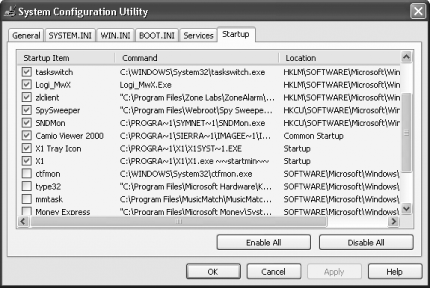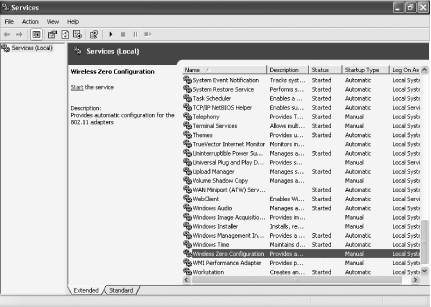Recipe 6.7. Shutting Down Unnecessary Programs and Services that Run on Startup
ProblemYou want to stop unnecessary programs and services from running on startup, so that you can speed up the performance of your PC. SolutionStopping programs from running on startupStopping programs from running at startup is particularly difficult, because there is no single place you can go to stop them all. Some run because they're in the Startup folder, others because of Registry settings, and so on. So you'll have to combine several techniques to stop them from starting up automatically when you turn on or reboot your PC. Using a graphical user interfaceThere are several techniques you can use with a graphical user interface to stop programs from running on startup. Again, you'll have to combine several, and not rely on a single one. Clean out the Startup and Scheduled Tasks foldersThe Startup folder contains shortcuts that each run a program whenever you start or reboot your PC, so you can halt a program from running on startup by deleting shortcuts found in it. The Startup folder can be found in C:\Documents and Settings\<User Name>\Start Menu\Programs\Startup, where <User Name> is your Windows logon name. Delete the shortcuts of any programs you don't want to run on startup. As with any shortcuts, when you delete them, you're only deleting the shortcut, not the program itself. (You can also clear out the startup items by going to Start Next, clean out your Scheduled Tasks folder. Go to C:\WINDOWS\Tasks, and delete the shortcuts of any programs that you don't want to automatically run on a schedule.
The System Configuration UtilityDeleting shortcuts out of the Startup and Schedule Tasks folders will stop many programs from running at startup, but it won't kill all of them. Probably the best all-around tool for keeping programs from running is the System Configuration Utility, shown in Figure 6-4. To run it, type msconfig at a command prompt and press Enter. Figure 6-4. The Startup tab of the System Configuration Utility is the best place to halt programs from running on startup To stop a program from running at startup, click the Startup tab and uncheck the box next to it. It can sometimes be difficult to understand what programs are listed on the Startup tab. Some, such as America Online, are clearly labeled. But often, you'll see a phrase or collection of letters, such as ctfmon. In this case, ctfmons.exe is a program that activates Alternative User Input Text Input Processor (TIP) and the Microsoft Office Language Bar, which provides for text input services such as speech recognition and handwriting recognition. If you don't need those services, it's a good idea to stop this program from running on startup. To get more information about a listing, expand the width of the Command column near the top of the Startup tab. Expand it enough and you'll see the startup command that the program issues, including its location, such as C:\WINDOWS\System32\ctfmon.exe. The directory location should be another hint to help you know the name of the program. That won't always help, though. To get more information about any particular program, do a Google search on its filename, and most of the time you'll get useful information about what it is, what it does, and whether you need it. You can also go to the WinTasks Process Library at http://www.liutilities.com/products/wintaskspro/processlibrary/, which lists many programs that run on startup, and details what they are and whether they're necessary. When stopping programs from running at startup, it's best to stop them one at a time rather than in groups. You want to make sure that you're not causing any system problems by stopping them. So stop one and restart your PC. If your PC runs fine, then stop another program and restart. Continue doing this until you've cleared all the programs you don't want to run automatically. Each time you uncheck a box and restart your PC, you'll get a warning, telling you that you've used the System Configuration Utility to disable a program from starting automatically. If you don't want to see that warning appear, disable it by checking in the proper box in the dialog. After you've used the System Configuration Utility to identify programs that run on startup, you may want to try disabling them from with the programs themselves. So run each program that starts automatically, and see if you can find a setting that will allow you to halt it from running on startup. Using the RegistryThe System Configuration Utility won't necessarily let you identify and kill all programs that run on startup, but you can use the Registry to find others. Open the Registry Editor, and go to HKEY_CURRENT_USER\Software\Microsoft\Windows\CurrentVersion\Run. Listed in the right pane will be some of the programs that automatically run at startup. The Data field tells you the path and name of the executable so that you can determine what each program is. Right-click on any program you don't want to run and choose Delete. That will kill any programs that run specific to your logon. To kill programs that run for every user of the system, go to HKEY_LOCAL_MACHINE\SOFTWARE\Microsoft\Windows\CurrentVersion\Run and follow the same instructions for deleting other files you don't want to run at startup. Again, for help deciding which to kill and which to run, try Google and http://www.liutilities.com/products/wintaskspro/processlibrary. Disable services that run at startupConstantly running in the background of XP are services processes that help the operating system run or that provide support to applications. Many of these services launch automatically at startup. And while you need many of them, there are also many that aren't required and that can slow your system down while they run in the background. Here's how to stop unnecessary ones from running. Using a graphical user interfaceThere are several techniques you can use with a graphical user interface to stop services from running on startup. You should combine several, and not rely on a single one. The System Configuration UtilityYou can disable services at startup by using the System Configuration Utility, in a similar way that you halt programs from running at startup, except that you use the Services tab instead of the Startup tab. Other than that, you use the utility the same, as outlined previously in this recipe. The Services Computer Management ConsoleWhen you disable a service through System Configuration Utility, there's often no way to know what it does. So an even better way of disabling services at startup is via the Services Computer Management Console, shown in Figure 6-5. Run it by typing services.msc at the command prompt. The Services Computer Management Console includes a description of all services, so that you can know ahead of time whether it's one you want to turn off. It also lets you pause the service, so that you can test out your machine with the service off, to see whether it's needed or not. Figure 6-5. The Services Computer Management Console is a better tool than the System Configuration Utility for halting services that run on startup, because it includes descriptions of each service and an easy way to stop them from running on startup After you run the console, click the Extended tab. This view will show you a description of each service in the left-hand pane when you highlight the service. The Startup Type column shows you which services launch on startup any services with an Automatic in that column launch on startup. Click that column to sort together all the services that automatically launch on startup. Then highlight each of those services, and read the descriptions. When you find a service you want to disable, right-click it and choose Properties. In the Properties dialog box that appears, chose Manual from the Startup type drop-down list. The service won't start automatically from now on, but you can start it manually via the console. If you want the service disabled so that it can't be run, choose Disabled. To test the effects of turning off the service, turn off any services that you don't want to run by clicking "Stop the service" in the left pane, or by right-clicking on the service and choosing Stop. Table 6-2 lists common services you might want to halt from running at startup.
DiscussionThe main reason for shutting down unnecessary programs and services that automatically run on startup isn't to make your PC boot faster, although that's a useful side effect. You primarily want to turn them off because they slow down your PC by using RAM and CPU time, while serving no purpose. And you also want to turn them off because they may conflict with programs that you need to run. You'd be surprised at how many services and programs run on startup without your knowledge. Many don't announce themselves or show any visible signs of being run; they won't even show up in the System Tray. Some programs, of course, such as antivirus software, should run automatically at startup and always run on your computer. But many other programs, such as instant messenger software, serve no purpose by being run at startup. And while you need a variety of background services running on your PC in order for XP to function, there are many unnecessary services that run on startup for example, on many systems, the Wireless Zero Configuration Service runs to automatically configure a WiFi (802.11) network card, even though no such card is present in the system. You can also turn off Simple Service Discovery Protocol (SSDP) and Universal Plug and Play (UPnP). See AlsoWinTasks Standard and WinTasks Professional will both help you find out what programs and processes automatically load on startup, and then shut them down for you. The Standard version costs $29.95, and the Professional version costs $69.95. The Professional version includes many extra features, such as logging, a scripting language, the ability to list information about DLLs, and more. For information, go to http://www.liutilities.com. You can try them before buying them. An excellent program for managing all phases of startup is Autoruns, available at http://www.sysinternals.com/ntw2k/freeware/autoruns.shtml. |
EAN: 2147483647
Pages: 408
 Programs
Programs 